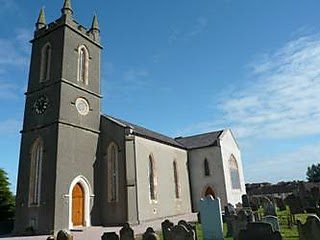Investigating Comber's rich history

Andrews Memorial Primary School Comber
Andrews Memorial Primary School are exploring their local area.
Comber
The County Down town of Comber may be small in size but it is big in terms of history and particularly famous for its potatoes! Their potatoes are eaten around the world, and after achieving EU Protected Geographical Indication status in 2012, the Comber potato (Comber Earlies) became a global brand.
History
Comber became a centre for linen production and grain processing by the second half of the 1700s, with whiskey distilling also a prominent industry in the area in the 1800s. By the late 18th Century, Comber had various highly productive mills, including the flax spinning mill which opened in 1864 and operated until 1997.

Newsline reports on the old mill in Comber.
大象传媒 Newsline reports on the closing down of the old mill in Comber on 25 March, 1997.
Military past
Comber's history is etched with strong military connections, that are marked by memorials in the town.
In the Square stands an imposing 55 feet high column, which is a statue to Major General Rober 'Rollo Gillespie', who was born in Comber in 1776, and became famous for his heroic efforts fighting in India in the 19th Century. While leading an attack on a fort in the Himalayas, Major Gillespie fought on despite having no ammunition, allegedly shouting: "One more shot for the honour of Down".
Edmund De Wind, another resident of Comber, was posthumously awarded the highest military that can be given to a member of the British Army, the Victoria Cross (VC), for his actions while fighting in France in 1918 during World War One.
For seven hours he held his post, and though twice wounded and almost single-handed, he maintained his position, repelling many German attacks until he was mortally wounded and collapsed. There's a VC commemorative stone in Edmund De Wind's memory mounted on a plinth in Comber and a street in the town is named after him.
In 1923 Comber's War Memorial was unveiled, and in 1952 Memorial Gardens were laid out in memory of those who fought and died in World War Two.
Memorial Hall
Comber is now synonymous with the famous ship Titanic, thanks to Thomas Andrews, whose family had been part of life in the town for generations. Thomas Andrews was a naval architect and took over as Chief Designer of Titanic in 1910.
He was on board when the ship sank on 15 April 1912 on its maiden voyage. Andrews lost his life in the disaster, with eyewitnesses later recounting how in his final moments he was throwing deckchairs overboard in an attempt to help people fighting for their lives in the freezing water.
The Andrews Memorial Hall in Comber was built in his memory. His daughter Elizabeth symbolically broke ground at the site in October 1913 as work began on the hall, with his mother laying a foundation stone for it in January 1914.
Both events are recorded by inscribed granite blocks set into the main facade of the hall. It was officially opened by Thomas Andrews' widow, Helen, on 29 January 1915.
For many years it was used as a community hall before becoming part of Andrews Memorial Primary School, initially serving as temporary classroom space until the school was completed in 1979. The school is very proud of its link to Thomas Andrews.
There is also a Titanic memorial in the town to those who died on the ship and a Comber Titanic Audio Trail.
Why not explore your local town’s memorials and find out why they were erected?





